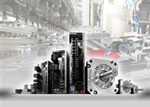15 January 2014
Mitsubishi Electric leads trend in motion and servo technology
 User expectations for motion control and servo technologies are changing, with more emphasis being placed on ease of installation, energy efficiency, safety and productivity. Barry Weller of Mitsubishi Electric looks at the current trends and the future of these vital technologies.
User expectations for motion control and servo technologies are changing, with more emphasis being placed on ease of installation, energy efficiency, safety and productivity. Barry Weller of Mitsubishi Electric looks at the current trends and the future of these vital technologies.
High-precision servo motors, intelligent servo amplifiers and high speed motion controllers have been available for many years, and have developed steadily over that time. There are many established uses for servos and motion control, and probably just as many potential new users that are yet to adopt the technology.
Today’s emerging trends and new developments provide a guide to how servos are likely to advance in the coming years. Mitsubishi Electric’s new MR-J4 servos, launched this month, embody many new features that are expected to become the norm over time.
One aspect that the market is always keen on is improving ease of use or ‘user-friendliness’. Commonly one of the most time consuming parts of any servo system is tuning the servo motor to the machine it is installed in. The result of not tuning the servo properly is an underperforming machine or irregular production. Usually the person tuning the system needs a high-level of both training and experience. By giving the servo amplifier the intelligence to do this tuning the commissioning time is reduced. The MR-J4 Servo amplifier achieves this with its ‘One Touch Tuning Function’, using this function the engineer simply chooses from 3 different types of machine criteria and lets the servo amplifier do the rest. The servo amplifier then tunes to the machine, any machine resonance points are detected and automatically filtered out. Even machine vibration can be suppressed. Of course some of these resonance points may change over time due to machine wear. To overcome this, the fillers can be set to continually adjust over the life of the machine.
The latest amplifiers also have a ‘Machine Diagnosis Function’ that monitors not just the actual condition of internal components such as capacitors and relays, but also external components like the bearings, belts or ball screws. The system then notifies the user regarding any degradation in operation. This makes both unplanned downtime and machine outage time a thing of the past and can therefore make a significant contribution to long-term productivity. If an alarm does occur the internal drive recorder gives the maintenance engineer full diagnostic information before and after the alarm occurrence. This makes the cause of the alarm easy and quick to identify, reducing any downtime.
Safe operation
Functional safety requirements are continuing to evolve and become more demanding. Mitsubishi’s MR-J4 amplifiers have an integrated two-channel STO (Safe Torque Off) input. This can be augmented by an additional option module to provide SS1 (Safe Stop) input in line with EN61800-5-2. The system configuration then also supports SIL2 (EN62061) and PLd (EN13849-1). Embedding the safety on the amplifiers gives greater flexibility in its use and also reduces machine start-up times after the cause of the safety stoppage has been resolved.
Servo motors have always been at the forefront of accuracy. This accuracy helps manufactures reduce the amount of raw materials used in production and increase the product quality, so there is a constant drive to improve this accuracy. The MR-J4 amplifiers, for example, are being fitted with 22-bit absolute encoders as standard, providing a resolution that corresponds to more than 4 million pulses per revolution. This resolution not only increases accuracy but also gives a smoother motor rotation, often known as cogging.
Environment
Environmental issues are on the top of everyone’s priory list and often we are looking at how technology can help reduce our carbon foot print. This could be looked at in many ways from energy saving to the amounts of raw material used. For these reasons Mitsubishi Electric has developed dedicated two and three-axis amplifiers that provide cost, space and energy savings compared to using a set of single-axis amplifiers. These amplifiers also offer significant reductions in wiring and commissioning times.
The design of the servo motor itself is also being refined. One of the key ingredients in the motor construction is a material known as rare-earth magnets. The MR-J4 range of motors use 30 percent less metal than the previous generation whilst still increasing its performance.
The MR-J4 motors range is available in 200V and 400V and includes power ratings from 100W to 22kW. The MR-J4 servo motors are designed for compliance with either IP65 (dustproof), IP67 (washdown) or to food and beverage hygiene standards.
Therefore, we can summarise that servos and motion control technologies have developed a long way over the last 20 years and are likely to continue developing for many years to come. Similarly, the market is evolving and growing as new application areas are opening up. There are many drivers for this including: steadily falling servo costs and rising performance levels, new fields being automated (e.g. medical procedures), servos replacing other technologies such as hydraulics or steppers, increasing awareness by user groups, and developing geographic regions.
The emerging generation of servo technology represents a significant advance on current standards and we can be sure that new developments will continue to emerge for many years yet.
- Contact Information
- Name: Wayne Hipkiss
- Email: sales@worldmc.co.uk
- Website: gb3a.mitsubishielectric.com/fa/en

